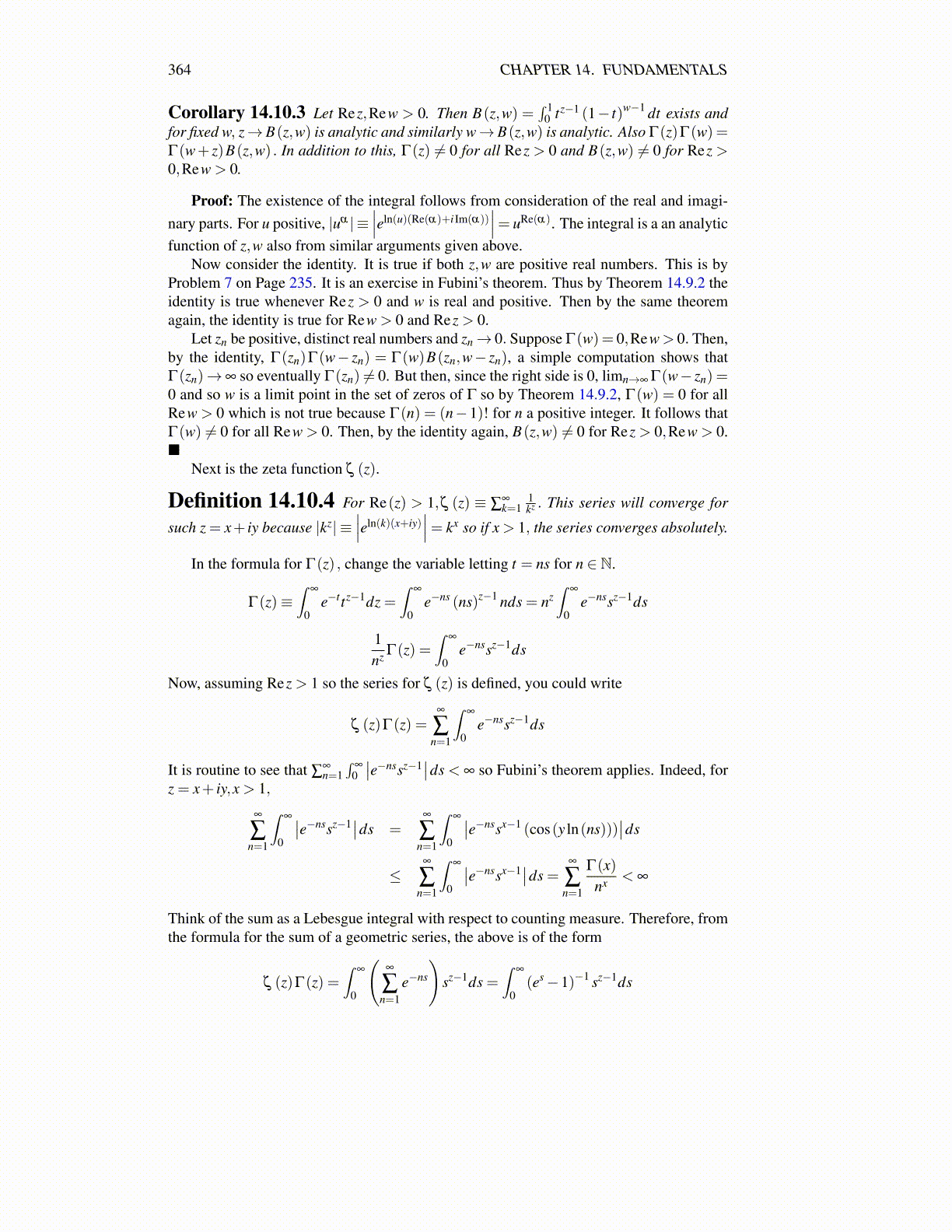
364 CHAPTER 14. FUNDAMENTALS
Corollary 14.10.3 Let Rez,Rew > 0. Then B(z,w) =∫ 1
0 tz−1 (1− t)w−1 dt exists andfor fixed w, z→B(z,w) is analytic and similarly w→B(z,w) is analytic. Also Γ(z)Γ(w) =Γ(w+ z)B(z,w) . In addition to this, Γ(z) ̸= 0 for all Rez > 0 and B(z,w) ̸= 0 for Rez >0,Rew > 0.
Proof: The existence of the integral follows from consideration of the real and imagi-nary parts. For u positive, |uα | ≡
∣∣∣eln(u)(Re(α)+i Im(α))∣∣∣= uRe(α). The integral is a an analytic
function of z,w also from similar arguments given above.Now consider the identity. It is true if both z,w are positive real numbers. This is by
Problem 7 on Page 235. It is an exercise in Fubini’s theorem. Thus by Theorem 14.9.2 theidentity is true whenever Rez > 0 and w is real and positive. Then by the same theoremagain, the identity is true for Rew > 0 and Rez > 0.
Let zn be positive, distinct real numbers and zn→ 0. Suppose Γ(w) = 0,Rew> 0. Then,by the identity, Γ(zn)Γ(w− zn) = Γ(w)B(zn,w− zn), a simple computation shows thatΓ(zn)→∞ so eventually Γ(zn) ̸= 0. But then, since the right side is 0, limn→∞ Γ(w− zn) =0 and so w is a limit point in the set of zeros of Γ so by Theorem 14.9.2, Γ(w) = 0 for allRew > 0 which is not true because Γ(n) = (n−1)! for n a positive integer. It follows thatΓ(w) ̸= 0 for all Rew > 0. Then, by the identity again, B(z,w) ̸= 0 for Rez > 0,Rew > 0.■
Next is the zeta function ζ (z).
Definition 14.10.4 For Re(z) > 1,ζ (z) ≡ ∑∞k=1
1kz . This series will converge for
such z = x+ iy because |kz| ≡∣∣∣eln(k)(x+iy)
∣∣∣= kx so if x > 1, the series converges absolutely.
In the formula for Γ(z) , change the variable letting t = ns for n ∈ N.
Γ(z)≡∫
∞
0e−ttz−1dz =
∫∞
0e−ns (ns)z−1 nds = nz
∫∞
0e−nssz−1ds
1nz Γ(z) =
∫∞
0e−nssz−1ds
Now, assuming Rez > 1 so the series for ζ (z) is defined, you could write
ζ (z)Γ(z) =∞
∑n=1
∫∞
0e−nssz−1ds
It is routine to see that ∑∞n=1
∫∞
0
∣∣e−nssz−1∣∣ds < ∞ so Fubini’s theorem applies. Indeed, for
z = x+ iy,x > 1,
∞
∑n=1
∫∞
0
∣∣e−nssz−1∣∣ds =∞
∑n=1
∫∞
0
∣∣e−nssx−1 (cos(y ln(ns)))∣∣ds
≤∞
∑n=1
∫∞
0
∣∣e−nssx−1∣∣ds =∞
∑n=1
Γ(x)nx < ∞
Think of the sum as a Lebesgue integral with respect to counting measure. Therefore, fromthe formula for the sum of a geometric series, the above is of the form
ζ (z)Γ(z) =∫
∞
0
(∞
∑n=1
e−ns
)sz−1ds =
∫∞
0(es−1)−1 sz−1ds